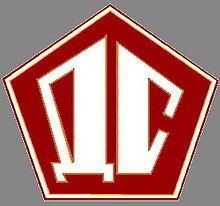 | ||
Dalstroy firekid
Dalstroy (Russian: Дальстро́й, [dɐlʲˈstroj]), also known as Far North Construction Trust, was an organization set up in 1931 by the Soviet NKVD (the predecessor of the KGB) in order to manage road construction and the mining of gold in the Chukotka region of the Russian Far East, now known as Kolyma. Initially it was established as State Trust for Road and Industrial Construction in the Upper Kolyma Area. After the 1952 reorganization it was known as Main Directorate of Camps and Construction of the Far North.
Contents
- Dalstroy firekid
- Dalstroy architect
- Scope of activities
- Ships of the Dalstroy
- Dalstroy leaders
- Disbanding
- References
Dalstroy oversaw the development and mining of the area using forced labor (slave labor). Over the years, Dalstroy created some 80 Gulag camps across the Kolyma region. As a result of a number of decisions, the total area covered by Dalstroy grew to three million square kilometers by 1951. The town of Magadan was the base for these activities.
Dalstroy architect
Scope of activities
The Dalstroy region is often referred to as Kolyma as it was centered largely on gold-mining in the upper reaches of the Kolyma River.
Dalstroy administered basically all aspects of the region: territorial administration, economic activities, and labor camps.
The administration of Dalstroy grew increasingly complex over the years, not only as a result of various geographical centers but also as units were created to manage geological surveying, motorized transport, management of secondary economies, road administration, steamship navigation on the River Kolma, and port and terminal management.
In his book Red Arctic, John McCannon explains how Dalstroy initially relied on Glavsevmorput or GUSMP, Russian acronym for Main Administration of the Northern Sea Route, a Soviet agency for exploiting resources across the far north, for coordination of supplies and transport. Glavsevmorput managed railway traffic to Vladivostok and shipping from there to Magadan. Over the years, however, as Dalstroy grew more powerful, its director Eduard Berzin obtained ships of his own so as to have more freedom of action. By 1938, when Glavsevmorput lost much of its political support, Dalstroy was firmly in control.
Ships of the Dalstroy
An account of the many ships used over the years to transport prisoners across the Sea of Okhotsk to Magadan as well as to the Arctic port of Ambarchik is given by Martin Bollinger in his book Stalin's Slave Ships. Among the Dalstroy fleet were the following ships:
In addition, several ships of the Far East State Sea Shipping Company were used at times to transport prisoners to various locations operated by Dalstroy. Examples include SS Nevastroi, SS Dneprostroi, SS Shaturstroi, SS Syasstroi, SS KIM, and SS Kiev.
Dalstroy leaders
In the words of prisoner Ayyub Baghirov, "The entire administration of the Dalstroy - economic, administrative, physical and political - was in the hands of one person who was invested with many rights and privileges."
The officials in charge of Dalstroy were:
Disbanding
After Joseph Stalin's death in 1953, the reorganization of the Dalstroy basically split its functions into three parts. The administration of labor camps was reorganized into USVITL (North-East Corrective Labor-Force Administration) of Gulag. The administration of the territory and local Communist Party of the Soviet Union apparatus were subordinated to the newly created Magadan Oblast and other adjacent territorial subdivisions. Dalstroy remained a purely economic enterprise.
